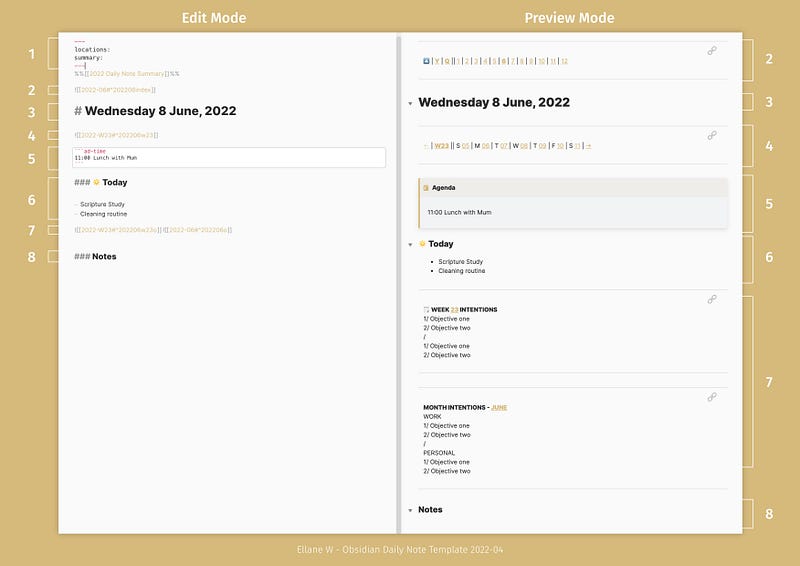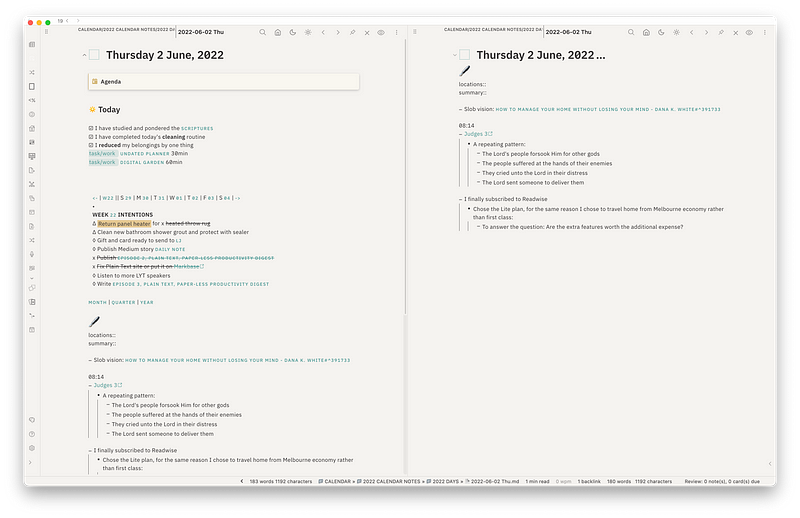Revamping My Obsidian Daily Note for Enhanced Clarity and Focus
Written on
Chapter 1: Rethinking My Daily Note Setup
My daily note in Obsidian was brimming with motivational goals and planning details.
While this can be beneficial when I’m focused on timelines and objectives, it often became a major distraction when all I wanted was to concentrate on the day’s log — the thoughts, insights, and information that arise in real time.
The primary advantage of maintaining a daily note is that it minimizes the obstacles to capturing thoughts and ideas. However, I found myself getting sidetracked by broader goals instead of focusing on what was truly relevant in the moment.
Inspired by an outlining technique from Logseq, I made some adjustments to my section headings. This allowed me to conceal the planner and goals sections beneath the date header. By implementing these changes, I embraced two key principles essential for any efficient knowledge worker:
- Simplification
- Concentration on the essentials
For those new to Obsidian, I recommend ignoring the complex strategies you might encounter. Simply start a daily note and jot down anything noteworthy or important. Like a hermit crab, you'll instinctively know when it's time to move on.
Section 1.1: Principle 1 - Streamline Your Process
Before making these enhancements, my daily note looked quite different. Here’s a glimpse of my previous setup:

For any additional details not thoroughly covered here, refer to that earlier setup. If anything remains unclear, feel free to ask in the comments.

I still appreciate the traditional planner layout with all its daily, weekly, and monthly links. However, I now prefer to access these on demand using the Hover Editor plugin. Instead of displaying all months at the top of each daily entry, they now only appear on the monthly page, accessible by hovering over the dotted rectangle adjacent to the date.
Other adjustments include:
- Week dates and intentions are retained on the week page provided by the Periodic Notes plugin and are transcluded onto the daily note.
- The YAML front matter has been removed, with location and summary fields now integrated into the Notes section.
- Each week is transcluded onto the month page for a consolidated week-by-week overview. I could theoretically omit the week section from the daily note since it’s visible when hovering over the dotted rectangle, but I prefer its appearance, and principle 2 addresses any clutter concerns.
Section 1.2: Principle 2 - Prioritize What Matters
A simple formatting tweak can effectively hide unnecessary dates behind the day of the week. By making the weekday header an H1, all preceding text can be collapsed until the next H1 appears.
I intentionally made the Notes section heading less prominent than the day of the week, denoting it with an H1 emoji of a pen.
By clicking the triangle next to the weekday, I can instantly collapse my agenda, to-do list, and dates, allowing me to focus on the expansive blank area for my notes.
After spending time with Logseq, I’ve become enamored with its straightforward approach to daily notes. While I typically write in outlines, I appreciate that I can also create longer text entries.
Outlining is almost a natural tendency in Logseq, which is one of several reasons I’m not transitioning to it.
Chapter 2: The Daily Note as an Essential Tool
In the video "Obsidian Daily Note Roll-up (Weekly, Monthly, Quarterly, and Yearly) - WIP," explore how to effectively manage various timeframes within your daily notes.
The second video, "EASY Task Management in Obsidian," provides insights into streamlining task management within the Obsidian environment.
Make the most of your daily note as a repository for everything that resonates with you on that date. Utilize tags and links where relevant, and expand sections that require more detail into separate notes using the Note Refactor plugin.
Remember not to overcomplicate things. As Ramses Oudt wisely stated, "Don't make it bigger than it is."
The primary benefit of maintaining a daily note lies in its ability to lower the barriers to capturing thoughts and ideas. When you no longer have to ponder where to place information, you can concentrate on the content itself, rather than its organization. Reallocation can happen later, if necessary.
Listen to your notes and your system; over time, they'll guide you on where to condense or elaborate.